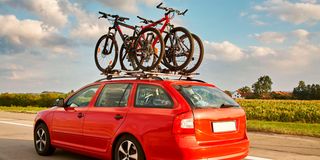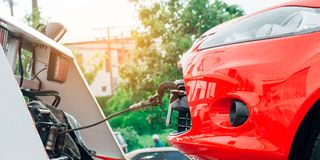Premium
Motor Clinic: What are you carrying on your car and how should you be carrying it?

A car with luggage container.
What are the laws we need to know regarding carrying goods in a private saloon or pick-up? We hear stories of people being stopped at checks for carrying loads that are normal and carefully packed. We also see many, many small vehicles (especially boda bodas) carrying all sorts of heavy and bulky stuff such as furniture and sacks, even iron sheets. Are there laws that address this?
Mwangi
Short answer: The applied rules depend on which policeman you are talking to. That anomaly is so stark and so prevalent that it needs no further elaboration.
Longer answer: The formal laws on carrying goods in any vehicle focus primarily on maximum weight, physical size, the legality of the goods, and the secure safety of the loading. The weight limit is determined by the licensed carrying capacity of the vehicle. The size usually means the load must be contained within the dimensions of the vehicle’s body in length and width. It is permitted, within reason, to load beyond the vehicle’s normal height, for instance on a roadworthy roof rack. To the best of my knowledge, it is not forbidden to carry a load that slightly overhangs the rear of the vehicle, but this must be within reason (a proportion of the wheelbase) and a highly visible red flag should be attached at the rearmost point.
Legality arises if the goods are prescribed (subject to cess and licensing for large scale commercial transport), or proscribed (forbidden), or contraband or stolen. There are specific controls if the goods are inherently dangerous, for instance inflammable or explosive. There are all sorts of subsidiary rules for heavy goods commercial transport and public transport that do not apply to small or private vehicles.
Secure loading applies to any goods in any part of the vehicle, but particularly to external loads in open pick-ups and on roof racks. Overhead and boot-mounted racks have always been legal, they were used even before cars had roofs. In sum, the loading should not be “dangerous” to the occupants, other vehicles or other road users. The chances of goods falling off while the vehicle is moving should be nil, even if the vehicle is involved in an accident.
All of these provisions are valid and indeed necessary. If you are in any doubt whether your load complies on any particular journey, for peace of mind you might want to get a permit from KENHA or your local police station or chief’s office.
As a practical example of all this, I recently needed to carry the fibreglass canopy of a double-cab pick-up on the roof of a 4WD station wagon, on a journey of 600 kms.
Recognising it would look a bit unusual, and might be regarded as grounds for an opportunistic roadside check, I considered its compliance and safety.
It fitted within the length and width of the vehicle body and projected less than a metre above the roof. It weighed about 80 kilos, below the personal rule-of-thumb max, I use of 100 kilos, about 3 percent of the vehicle’s gross weight so it would have insignificant effect on the vehicle’s stability or centre of gravity. The steel roof rack is attached to the car by eight substantial bolted brackets. The canopy was bolted to that through hardwood batons. It was then further held down by four ratchet straps (two fore-and-aft, two side- to-side) with breaking strains of several hundred kilos each, and there was no possibility of any independent movement of the load forwards, backwards, sideways or upwards, even in the event of a severe accident.
On the first leg of the trip, from North Kinangop to Ngong (about 100 kms) there were eight roadside police checks. Four of them gave me a cheery wave, or at least that is what I presumed they were doing, the other four demanded that I stop, and without any check of the roof load declared that it was “dangerous”, and if I did not have a KENHA permit, they would charge me.

Two of them accepted my apologies for not knowing I needed a permit to carry legitimate goods, and my assurance that the load presented no danger of any kind to anybody.
Another also understood and wondered if I would like to buy him lunch. I never carry cash but said I would be glad to buy him lunch if he would let me have his Mpesa number. He declined.
The fourth would not be comforted by my description of weights and bolts and straps, which actually made the canopy more secure than it would be if fitted to a pick-up, so I invited him and his four colleagues to put my claims to the test. If they could, all five of them in a combined heave-ho, make the load move more than 1millimetre, I would accept the charge of a dangerous load. I also offered to lend them a box of tools and a panga, to see if they could remove the load completely in less than half an hour. Alternatively, they were welcome to roll the vehicle onto its side into a nearby ditch, and I would sign an indemnity against damage if the canopy did not remain firmly attached. They returned my license and wished me a safe journey.
I passed a few more roadside checks on the rest of the trip, and only one paid me any attention at all…in a walk-by-look at every car in a spike-halted queue, he checked the tension of one strap and gave me a thumbs-up.
The moral of the story: it would be nice if the up-to-date Traffic Act was available on an open-access website, in a format that enabled word-search.

Here’s why a wash and polish can never be as good as new...
There are lots of clean and very shiny cars on the roads these days, but even a quick glance will tell you that they are not new or even nearly new. My car is newer than some of these cars yet it looks older at a glance. How do I change this?
Robert
The devil is in the details. Generally, clean and shiny is a condition that any undamaged and well-kept car can easily achieve. Absolutely clean and shiny is another matter. Your eye might not identify any specific fault or blemish, but your subconscious assessment will.
Go closer. Look in the smallest nooks and crannies and non-primary surfaces, especially where the paintwork joins rubber window seals and badges and other joints and creases and under trim strips, and in wheel arches and the underpan. On an old car there will almost certainly be a thin brown stain-line, perhaps only a millimetre wide, where panels or components join. Look at the rubber itself (less shiny?) and at the glass. As anyone who has replaced a windscreen will know, the new one is initially much clearer than the old, even if the old one had no visible damage. The old one would have thousands of tiny scratches, too small to individually see, but numerous enough to give the screen a different glaze. And the general paintwork, even if it is still shiny, has similar microscopic scratches from years of blasting with dust particles. The individual or collective blemishes may not be easily visible, but their overall effect is noticeable.

Car polish.
Even a very high-quality respray would also need the piece-by-piece cleaning or replacement of every attachment to look new, and still not fool an expert eye even without looking at the model year and the number plate.
The nearest you can get to “good as new” needs a valet service with intense detailing. That is a long, long labour of love and elbow grease and technical skills and partial dismantling as well as clever compounds. All those are needed to compete in the Concours d’Elegance, and may be justified to get a better sale price. But on a car you plan to keep, that’s a lot of time and effort for something that will never be more than nearly perfect. In the pipeline: paint-job options.
Lots of towing hitches, but very few trailers
A high proportion of private cars are fitted with towing hitches, but I seldom see any of them pulling a trailer. Is there some other reason for a tow hitch that I’m not aware of?
Francis

All cars are required to have a towing hook or towing eye, front and back, so if they are stranded they can be pulled out of trouble or out of the way. These are usually tucked underneath the front and rear bumpers, often to one side, either as a smooth hoop of strong steel or as a hefty hook with its open point facing the centre of the car.
The imperative is that they are attached to a very strong part of the chassis or subframe (something very unlikely to bend or break) to which they should be both welded and bolted as a belt-and-braces precaution. Their shape allows a very wide range of make-shift towing attachments to be quickly and easily connected, and the rescue vehicle, whether it belongs to emergency services or just a helpful passer-by, will have equivalent fittings.
Tow hooks are definitely not suitable for towing a trailer on a public road, or at speed, or over long distances. For that, you need a more sophisticated trailer hitch, which is even stronger than a hook, even more stoutly mounted, made of even higher quality steel, and which precisely matches a specific trailer coupling. They will also have an electrical plug and cable, so the trailer’s indicators, tail-lights, brake lights, and number-plate light can be connected to match the car’s own electrical systems.
Trailer hitches are useful in emergency rescue situations and are essential for any motorist with a trailer of any kind, even if it is only towed once in a blue moon, therefore, most of them will be empty most of the time, and only occasionally pull a boat or a safari trailer or a horse box.
The surprising thing is that they are not used by even more motorists even more often. They can give a medium-sized car the load capacity of a very big one at a fraction of the price difference and with almost no extra running or maintenance costs, and only when needed.
There are three main types of trailer hitch.
Drop pin: the crudest and simplest, used mainly in low speed agriculture.
The Pintle hook: used mainly by trucks where extremely heavy loads are involved.
The Ball-and-socket: most common on private cars (as an extra) and 4WDs (sometimes fitted as standard). Fitting is not technically difficult, but adequate reinforcement is needed at the mounting point. This is a very, very much more robust item than the middle of a modern bumper bar.
The basic design is just the way they hook up to a trailer, but on the trailer side, pintle and ball system can have extras if the trailer is fitted with its own brakes, which is mandatory if its loaded weight is more than 50 percent of the towing vehicle’s weight) and which allow the trailer to twist to extreme roll-over angles without discombobulating the towing car.





